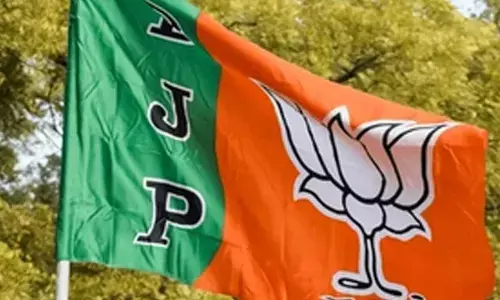A gender scorecard for politicians

Indian voters are known to research candidates using whatever tools are available to them before they vote. When information on gender governance and parity are accessible to voters, they may likely factor it into their vote.
Indian voters are known to research candidates using whatever tools are available to them before they vote. When information on gender governance and parity are accessible to voters, they may likely factor it into their vote.
These parameters can provide direction to voters on whom not to vote for, whom to disqualify and whom to reject, even though the picture is incomplete for selecting a candidate. This indicates that outcomes of elections can be slanted towards a more equitable India by making gender scorecards easily available.
That gender governance assessment is imperative should be obvious. India’s progress on women’s health, education, livelihood, political representation and other social indicators combined with the guarantee of constitutional rights is poor compared to the other 50 per cent.
Underserved, Under-represented, Under-valued. Closing the gap between who she is and who she can be, realising her human potential is India’s duty, one at which the country has scarily underperformed.
While leaps in female literacy, maternal health etc., provide cheer, it is unacceptable that a free an fair democracy isn’t quite that for half its people. Equally clear that no democracy can shine, its GDP grow and society progress with such handicap.
With elections around the corner in Goa, Punjab and Uttar Pradesh, it would do well to get started on gender scorecards for candidates and parties.
Elections in India
- Many Indians seem to approach elections like they would appear for examination.
- Here, the winners are predetermined due to being influenced by the “candidate/ party wave”.
- Electoral loss is viewed as personal failure by the voter in marking the “right” answer.
- This attitude places tremendous barriers on risk taking and thus not allowing new politics or radical change to appear.
Where does the fault lie?
- The voters have mentioned explicitly that they will not vote a candidate with a cold track record on gender.
- Derogatory comments, crimes against women or espousing gender inequality are viewed as disqualifiers.
- Yet, sexist and even misogynistic politicians are voted in, and in many cases repeatedly with huge majorities.
- The parties almost never impose penalties against sexism, be it demanding a public apology or for more serious violations- dismissal, demotion or denial of ticket.
- The standard approach of parties have been explaining it or distance themselves from the comment.
- Hence there is a need to combat sexism in politics and usher in more gender balanced governance. And voters have to initiate their right to vote for a suitable candidate.
What can be done?
- Indian voters are known to research candidates using whatever tools are available to them before they vote.
- Hence when information on gender governance and parity are accessible to voters, they may likely include it into their vote.
- These parameters can provide direction to voters on whom not to vote for, whom to disqualify and whom to reject despite the incomplete picture available for selecting the candidate.
- However, this can make the elections bend towards a more equitable India by making gender scorecards easily available.
Background:
- In past 70 years, sex ratio at birth has fallen from 946 to 887 though literacy and higher education have risen for men and women.
- Only 20% of urban educated working-age women work compared to over double that for men.
- There has been 14 times increase in trafficking of minor girls in last decade.
- Women are barely 10% of central government employees and 11% of the parliament and state legislatures averaged.
- Expenditures towards universal programmes have failed to deliver to women their rightful share. Gender specific programmes are barely funded and utilised.
- Thus, India’s progress on women’s health, education, livelihood, political representation and other social indicators along with guarantee of constitutional rights is poor compared to men.
Gender Scorecard means
- It is a report card on candidates and parties
- It will measure and rate their achievements on women’s development and rights across multiple axes.
- They are crucial in capturing evidence based metrics on gender inequity, disparity and imbalance the system.
- Ideally, gender scorecards must be put beside with good governance scorecards for a balanced 360 degree assessment.
Who use it
- Voters
- It will be a reference for them for their voting decisions at the local body, state or central level.
- Who publishes it?
- Any group with non partisan or partisan interests that provides voters information on parties’ and candidates’ performance.
- Interestingly, many groups — media houses, think tanks, policy institutes, women’s and advocacy groups and even parties themselves — can and should publish it.
- It will be upto public to refer to the ones they trust the most and make choices.
- Collating the card
- The gender score card on candidates and parties should not be assembled by taking surveys of candidates and parties since those responses are intended to say the things that will get them elected.
- Instead, it should record actual performance against gender development indicators from data and reports on the outcomes of policies effected and programmes implemented.
- Usage of MLA and MP funds for gender inclusion will also give insight into candidates and parties’ seriousness towards promoting equality and women empowerment.
- Over time, outcomes-based scorecards can be supplemented with performance scorecards. It can be even commissioned by representatives themselves, for live tracking, feedback and course correction.
- For instance, the Delhi Policy Group has done pioneering work ranking Indian states using gender indicators. However this “state of women in the states” does not assess political parties or candidates, so it not directly usable by voters.
A gender scorecard must evaluate a party or candidate in domains of Health
- Screening
- Cervical Cancer
- Addressing anemia
- Male birth Control
- Policies & Programmes
Education
- Sanitation in schools, colleges, hostels
- Campus Safety
- Study loans
- Higher education incentives
Livelihood
- Equal pay
- Day care
- Part time labour
- Entrepreneurs
- Tax exemption
- Paternity leave
- Public Transport
Infrastructure
- Running Water
- Electricity
- Public Transport
- Street Lights
- Public and Private sanitation
- Zoning
Safety
- Public Transport
- Female Police
- Women only police Stations
- Sex education in schools
- Gender sanitation at work
Life and Liberty
- Sexual harassment & rape laws
- Divorce
- Inheritance
- Emergency crisis
- services
Political Representation
- % in general ward/constituency
- % in cabinet
- High ranking judiciary
- Bureaucracy
- Central Government PSUs.
For parties, they should be assessed on bills passed and programmes implemented with success rates, and gender affirmative actions. Mere championing and lip service should not be counted.
What impacts the scorecard?
- Availability of data on outcomes of policies and programmes.
- India has serious paucity of comprehensive measurements, proper data presentation and transparency.
- There are numerous announcements of programmes and schemes but the performance and outcomes are inadequately measured.
Difference inimportance accorded
- It is important to weigh the verticals with the assumption that they differentially contribute to women’s socio-economic development.
- For example, lack of running water have a multiplier effect on women’s socio-economic progress as burden falls on them to fetch water for the family from distant sources. This leads to degradation of their education, employment and safety.
- Lack of toilets or safe transport can become overwhelming barriers for their development and safety.
- Thus it is important to assign equal weights to the verticals.
“What gets measured gets done” can be used as a method to steer socio-political change and combat gender imbalance.
Gender scorecards create healthy rivalry between candidates or parties and make them accountable to deliver an India for all, while keeping voters in the dark expands poor politics.


















